National park tour and night tour
Manuel Antonio National Park
People come to Manuel Antonio to visit the national park. It’s the most visited national park in Costa Rica, and also one of the smallest. It’s closed on Mondays to allow the place to recuperate, no more than 600 people are allowed in the park at once, and when the limit is reached it’s a one in one out policy.
Guided tour
We booked a guided tour and transfer that started early, the park opens at 7am and you need to get in first; of course everyone else has the same idea, so even if you get there as it opens you’ll be in amongst the crowds. You might think crowds would mean no wildlife, we found the opposite, and this tour was one of the most plentiful that we had. We were a group of about 10; a couple from Texas, a couple from Alaska, some Italians. Our guide was Felix, he was young, and couldn’t have been more than 20.
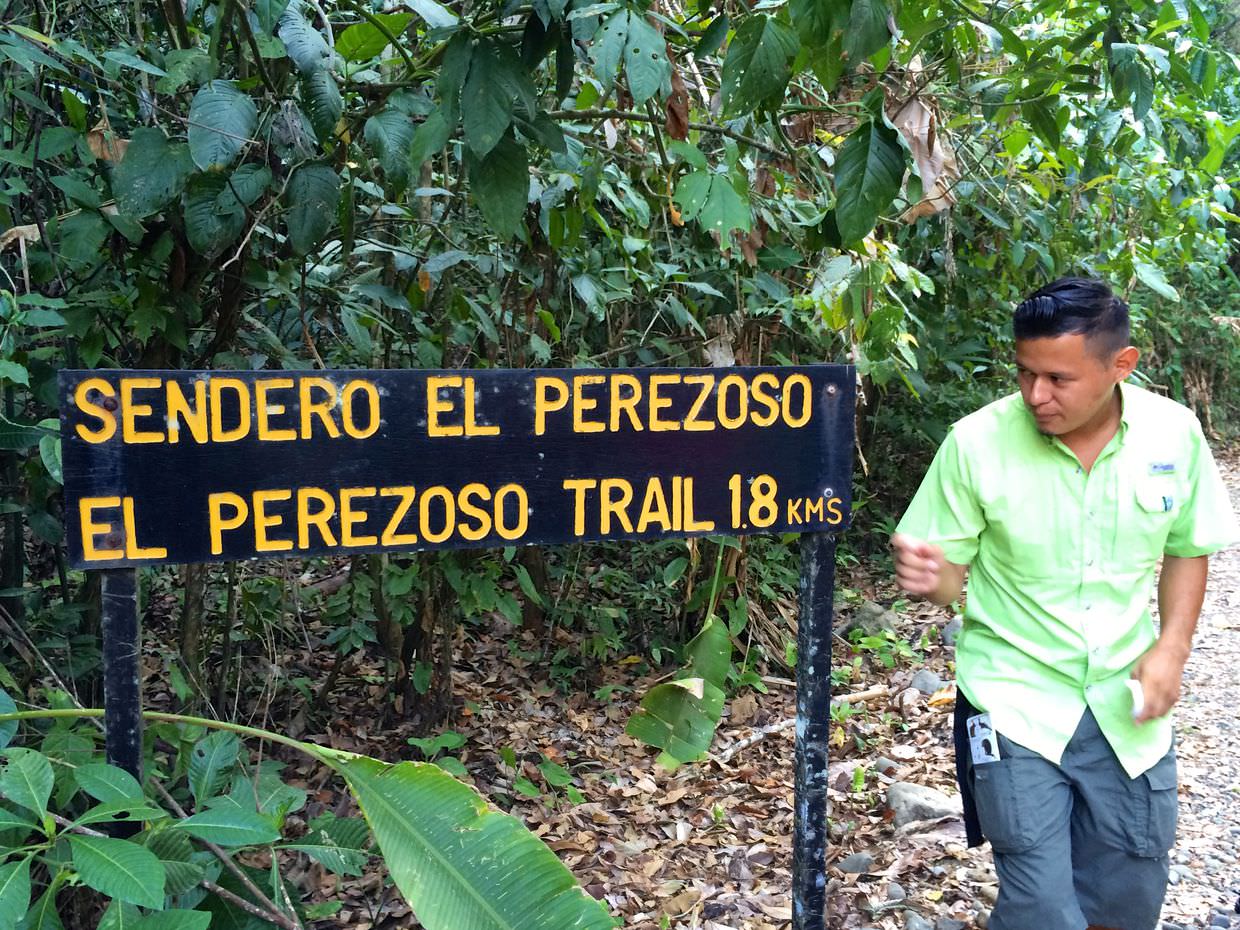
From the start there were animals everywhere. At the entrance there are of course capuchin monkeys, or as Felix called them, “mafia monkeys”; they’ll steal your food, or your plastic bags, especially down by the beach, while you’re having a swim.
From the path Felix invites us to look at a plant, “this lizard has the best camouflage, try and find it”. Our group all stare at it, looking hard around the leaves, trying to find this lizard. Even through the scope this lizard is hard to see – it perfectly resembles a clump of dead leaves. Gradually we all begin to see it. It was a type of casquehead lizard, the helmeted iguana or helmeted basilisk, identified based on the long tail and the fin-like protrusion on its head. We saw other lizards too, more Jesus Christ lizards, and little ground anole lizards.
Attention soon turned from the ground to the tree-tops. High above us a two-toed sloth (the bigger kind, one with canines and white fur), was climbing around, active early in the morning. “It’s moving loads”, Sam exclaims, so much in fact that we had to keep moving the scope to keep it in view. This was, until now, our best wild sloth spotting – it was the first sloth that wasn’t simply sleeping. As was a theme on this trip, Felix told us some details about these sloths, but not all of them aligned with what we’d learnt at the sanctuary – a lot of learnt but not questioned facts. Soon it moved and we could no longer see it, still again, and disguised.

A favourite for the guides on these types of tours is the fern that rolls up when you touch it. This particular fern collapsed its leaves on the first touch, and on the second the whole plant flops over. It takes about 30 mins to recover.
From the “sloth trail” road, we found another sloth. This was a sleeping three-toed sloth, with baby. While we all stared upwards a grey sambar deer walked behind us, nonchalantly munching on the shrubs at the roadside as crowds watched. In a branch a yellow clump hung down, on closer inspection it was a ball of wasps, “banana wasps” Felix called them, although that doesn’t seem to be a commonly used name – they were identified as Apoica pallens wasps using project noah, they’re nocturnal, which is why they weren’t moving. Also pointed out, a common brown basilisk lizard, a sleeping fruit bat and a large orb-weaver spider.
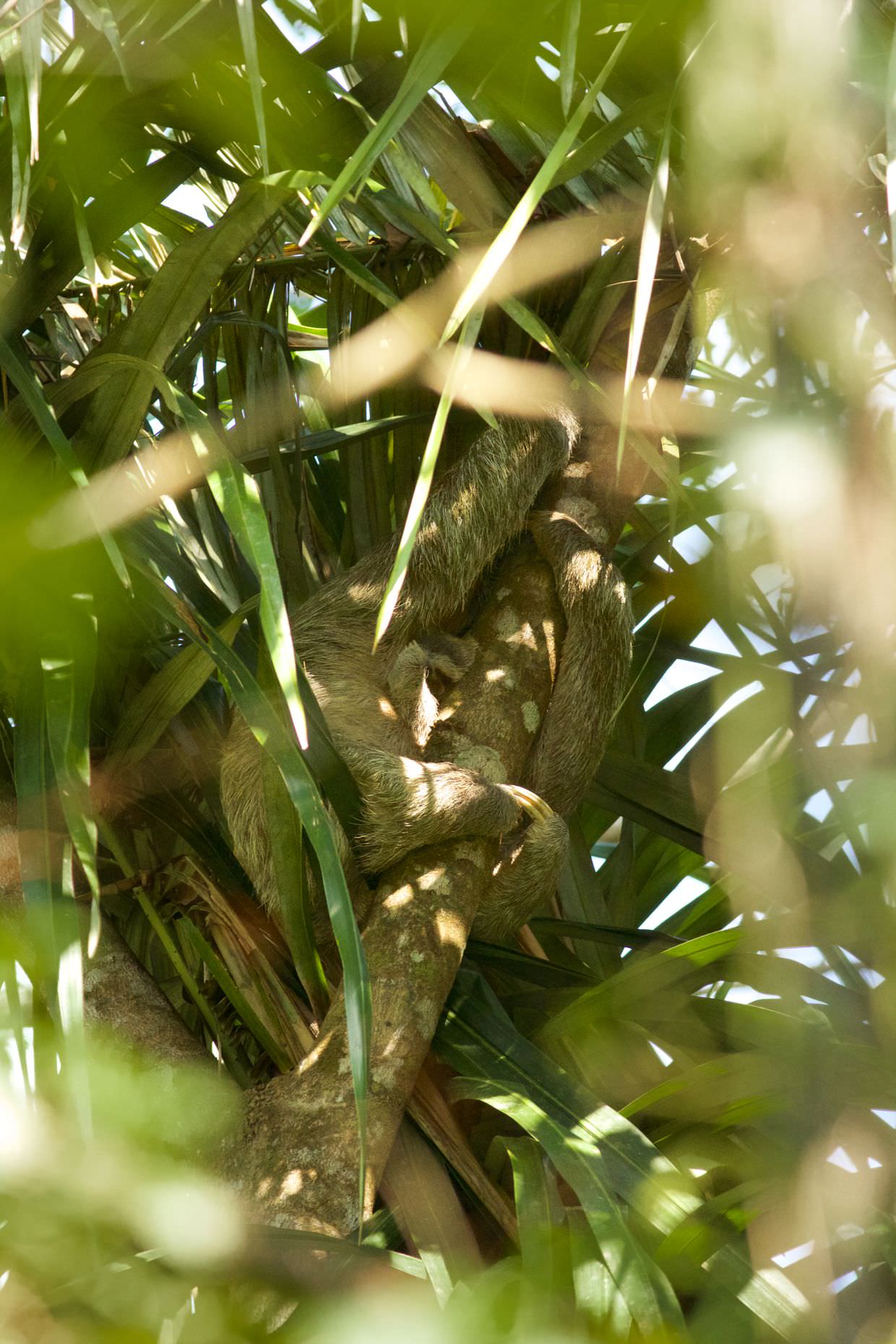


We thought the camouflage of the lizard was good; now we were asked to find a bird in the undergrowth right next to us. A bird that’s about a foot long, which nests on the ground. We couldn’t have been more than 6 feet away, none of us could see it. Felix put the scope on it, nope, still can’t see it. We stared and stared, eventually you might notice that there’s a shape that you might not see in dead leaves, a shape that resembles an eye; ok yes, I’ve got it. See if you can spot it in the picture below. Almost half the picture is bird. It’s a type of potoo bird, with a gape that opens wide like a whale to catch flies. This was, more specifically, a pauraque, a type of nightjar, and very similar to the lesser nighthawk or the dusky nightjar. High in the trees, sleeping on a branch, we found another similar bird in the same family, possibly the lesser nighthawk.
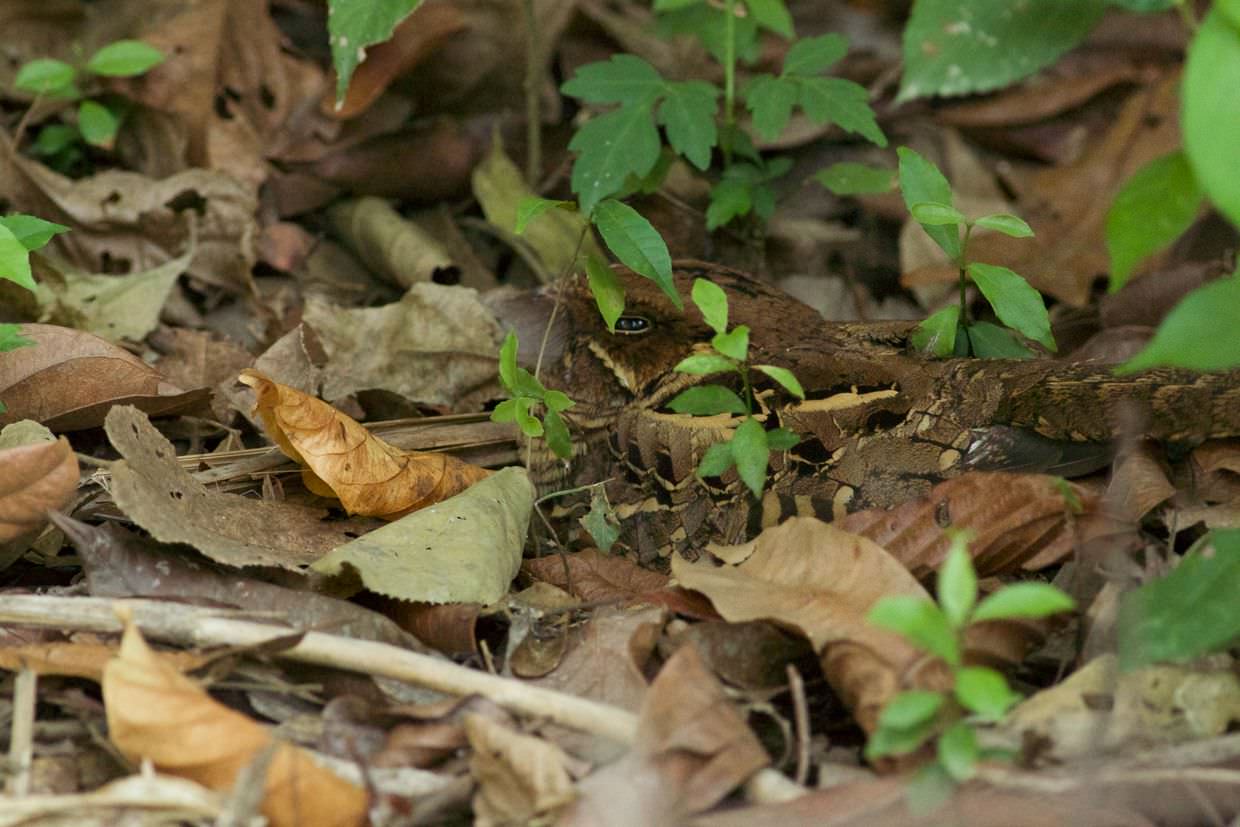

While the group were looking into the trees at a sleeping bat, nestled under the large leaves of a palm, I scanned the treetops for wildlife. Ahead a branch moved, just a capuchin monkey perhaps? I moved closer and found it was an active three-toed sloth. I pointed it out to the guide, and soon a crowd had gathered. This sloth begun to move down the tree, and was reaching out for some tasty looking leaves just out of reach, stretching, stretching, nope; try again, still can’t reach. Maybe from the other side, slowly moving back up, around, stretching, nope. And then back to sleep. This was our best wild sloth sighting; active, moving, smiling, and too close for the 400mm lens.


Beach

We came to the end of the sloth trail, and arrived at the golden sands of Playa Manuel Antonio. Here’s where our tour would end, Samantha and I decided to stay in the park a bit longer, go for a bit of a swim, and see what else we might find. The sea was warm and clear, and filled with sweaty hikers stripped down to their swimwear trying to cool off.
At the beach the capuchin monkeys know that we rest and eat food, so these omnivores are here in abundance. The cheeky monkeys try their luck with people’s bags, and anything left on the beach must be guarded closely.
Today too, we were in luck, another of Costa Rica’s four monkey species were near the beach – the Central American squirrel monkey (the grey-crowned subspecies). As our guide left he told us we were very lucky to see them, “you can come to Manuel Antonio everyday for 2 weeks and not see these”. These monkeys are endangered with as few as 5,000 left in the wild; since the 70s they’ve been hunted, captured for the illegal pet trade, and have suffered habitat loss through deforestation.

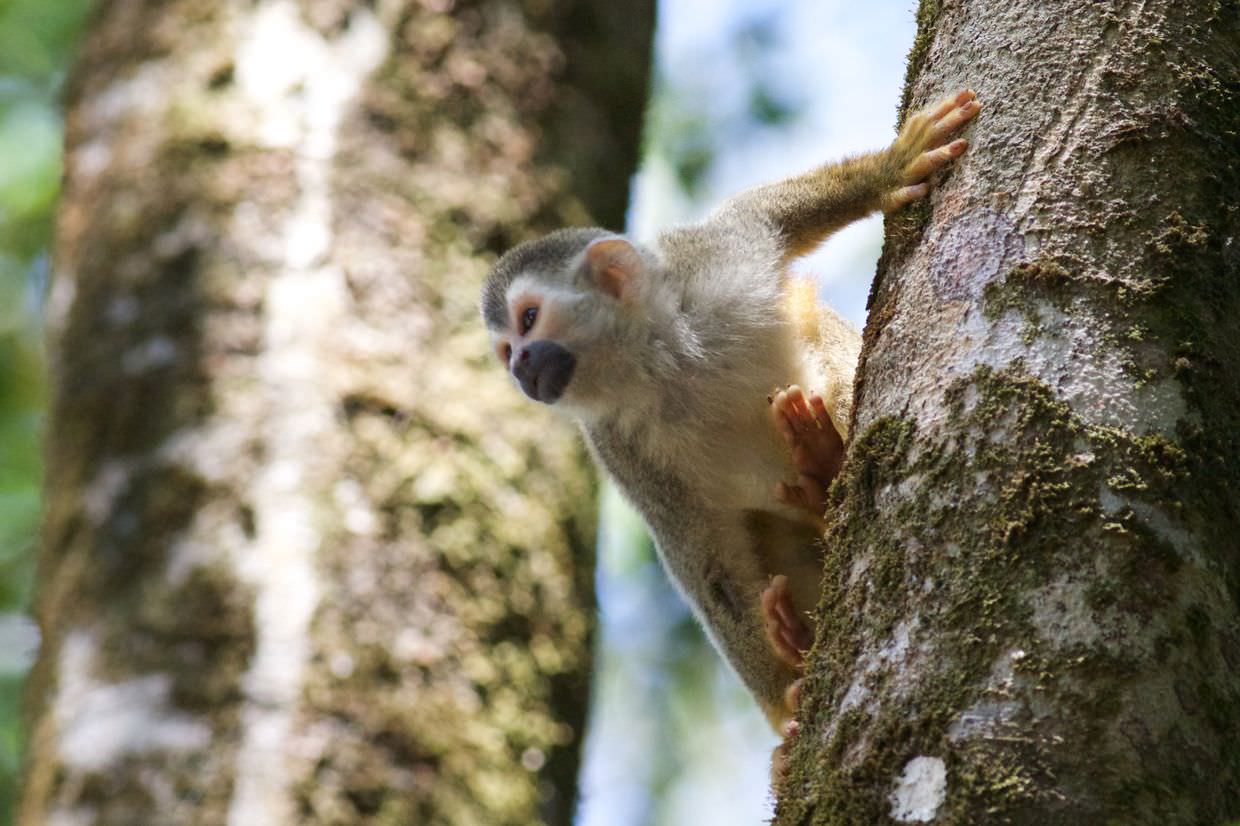
Squirrel monkeys live in groups, and we spotted about 15 of them, scuttling about the trees and resting on branches briefly before jumping up and foraging for insects beneath leaves, or screeching short chirps to their neighbours. They have dark black eyes and sharp canine fangs, at times they look evil, at others they look adorable. We hung around on the beach as long as they did, photographing them and enjoying their energetic presence.

In the hot late-morning heat we pushed on, keen to try out another section of the park. Continuing out to the hammer-like protrusion, we saw coati and racoons foraging for fruit, hermit crabs pulling their shells on the beach, more capuchin monkeys and what looked like the tribe’s alpha male. On a branch near to us, a large black ctenosaur crawled down – a type of iguana, and very fast moving, it was heading to the beach in search of food.


We didn’t make it far on our trail, we grew hot and sweaty, and rested before turning back. More monkeys were in the trees above, and hummingbirds flew close by, a loud humming noise approached and I had to check it wasn’t some giant beetle. On the way out we saw less wildlife, a red land crab, and of course, two more sloth sightings. There are so many sloths in this park.
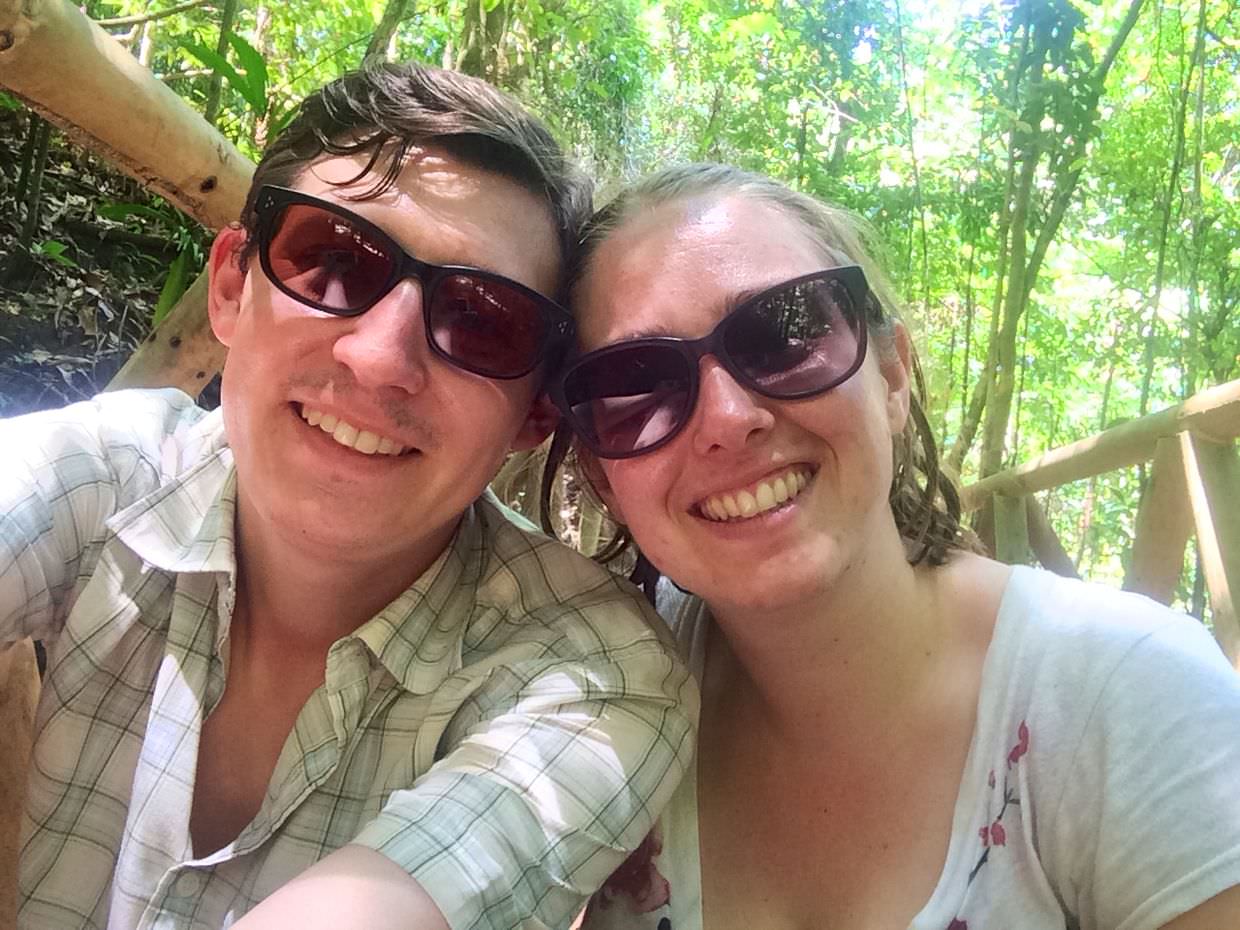
Falafel and desserts
We got the bus back up to Villas Nicolas; buses are regular and cheap. At our favourite Falafel bar we had smoothies, beer and falafel again, before decamping to the much-loved Cafe Milagro for desserts.
The afternoon was spent sleeping, resting by the pool, watching the toucans in the tree tops.
Night tour with Brian
Through our hotel we booked a night tour, “Night tour with Brian” it said, which was a bit ambiguous. Brian was Brian Jimenez, who runs the very well reviewed “Night tour Manuel Antonio” (TripAdvisor). Our pickup was at 6pm, about the same time as our hastily ordered but very tasty quesadillas arrived.
There were four of us tonight, we were joined by a hypnotherapist from Lancashire and his partner, a swedish journalist. In the comfortable air-conditioned van Brian drove us out to his reserve; a plot of land with trails, where the wild is simply invited in, for us to observe. Brian explained on the drive that he loves to learn about animal adaptations; the specific things creatures have done to adapt to their environment, or to get one-step ahead of their prey, or to avoid predators. Unlike the horribly noisy and busy night tour we had in Monteverde, this was something special; 4 of us, an expert guide with an in-depth knowledge of wildlife and the great outdoors – without sign or sound of humanity, just the constant hum of a jungle that’s alive. It was amazing.
Pauraque
Our first sighting was a common pauraque bird, like the one we’d seen earlier – but easier to see at night because its large eyes can’t help reflecting our torchlight. Brian explained a bit more about the bird, which we hadn’t learnt before; “it has gigantic eyes, like a potoo, and a giant mouth”; and he told us about its adaptations – “when they fly they open their mouth and it dislocates, it opens wide and the saliva in their mouth becomes sticky when it hits the wind – it becomes literally a fly trap”. I imagine a bird flying past that looks like a gaping whale. Later on we’d see another, and throughout the trail we could hear the occasional sound of the male vocalising.

Scorpions
In Monteverde we’d seen a bark scorpion briefly scuttle away, and were told that Costa Rica has two types of scorpions. Brian now corrects that misinformation, pointing out that Costa Rica is one of the most diverse places when it comes to Scorpion species. And now we get to see one up close. Brian shines a UV light into the grass and quickly we see a bright blue glow moving; a male bi-colour scorpion beaming in the purple light. “Oh my gosh!” Sam exclaims. It’s not poisonous though, however if it stings you it will hurt, a lot, and the pain which will die down could last for a few days. It’s all much worse if you’re allergic.

Brian is a fountain of wildlife knowledge; he explains why it’s a male, “its smaller, its tale and legs are shorter – a female needs to be stronger to carry young” (which they carry for 3 weeks). They usually eat cockroaches and crickets, but can eat things much bigger, their stinger injects a poison that begins to pre-digest an animal, liquefying them from the inside. On the underside of a scorpion are pedipalps, two arms that it uses to feel the world. Under the light we can see its body is covered with tiny black spots; sensors it uses to learn about its surroundings, “yeah, he knew we were coming”, Brian says.
As we walk away, Samantha almost stands on another, “Whoa!”, we only see it because it shines up bright blue. This one was missing a pincer and its stinger was damaged, it had been in a nasty fight. Brian picks it up so we can get a better look, and we can clearly see the pedipalps underneath – “they’re like feathers, like wings underneath”, Sam says. The tail itself is jointed so it can move in 360 degrees, and attack anywhere.
Dink frog
Its not the right time of year for frogs. Its the dry season, so the frogs aren’t very active, they aren’t vocalising, and most of them are high up in the trees keeping a low profile. In a pool of water in a plant Brian finds a tiny male Dink frog, again, its smaller than the females – which need to carry the male. Males have bigger toes for traction – to help them hold on. Dink frogs also exhibit an interesting evolutionary trait; when their eggs hatch they emerge as full grown frogs rather than tadpoles. The females are parental too, looking after the eggs and keeping them hydrated until they hatch.

Sounds of a potoo bird
After the frog and some hard working leaf-cutter ants we hush up. Quietly in the distance is the noise of a night bird, a common potoo bird is vocalising. “That’s really hard to hear, I hear it maybe 5 times a year”, Brian says. It sounded like these recordings. The potoo bird looks like an owl, but it’s not related to raptors.
Kinkajou
As we walked down the path there was a big movement in a tree to our right that made us stop and wait. “I think it could be a kinkajou”, Brian says, “or maybe an owl”. We wait a long time, there’s no further movement for now, we walk away, but plan to double back in a short while. A kinkajou, or “honey bear” is a peculiar animal, like a cross between a monkey and a cat; it has a prehensile tail that it grips with, and is related to racoons and coati – although unlike those carnivores it doesn’t eat meat, instead it has specialised in eating nectar and has a long tongue adaptation. When we return Brian spots the kinkajou, sitting still, camouflaged in the trees, its eyes reflecting our torchlight; suddenly it moves, crossing the path above us unseen, then exposing itself in the lower branches next to us – a brilliant spotting, we could see it was a male, and it quickly scarpered away into the foliage. Wow. “That is rare to see – it is not endangered, but sightings like this are rare. They are normally high in the treetops, having him exposed like this, walking across, is really unusual. This is a highlight”.

Of course the camera was on too low an ISO to capture anything but a blur, but still, you can tell it’s a male, ahem.
We were lucky again later in the trail, another kinkajou, or perhaps the same one, was sitting in some lower branches. It didn’t like us passing by and ran off into the trees. But the route it took wasn’t a good one, and for some reason it decided to turn back, run all the way back past us and into another tree – and on route, “Oh, oh, be careful, he’s pooping”, we avoided the falling poo. Two sightings, amazing.
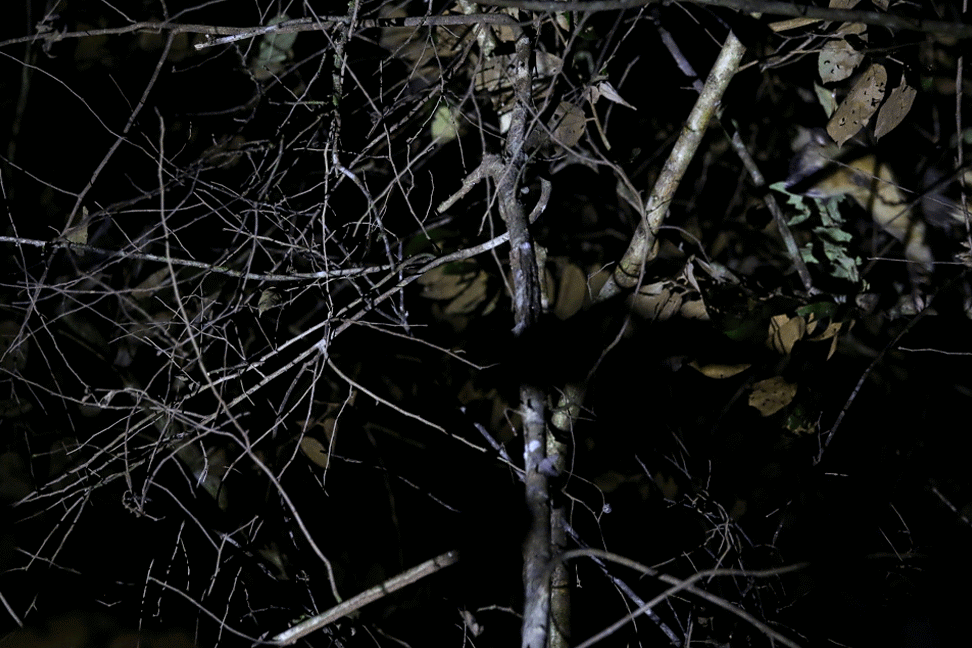
Brown Anole
On the ground Brian found a male brown anole lizard that should have been asleep. He showed us how the lizard does a “workout” move – like press ups, to attract a mate. As it does this, a colourful flap of skin beneath its jaw, a dewlap, is displayed.

Nearby we saw two giant geckos, one much larger than the other, the smaller seemed to have been in a fight. “Oh, that is an enormous gecko”.
Tailless whip scorpion
This arachnid ran out in front of us as we entered the dense forest. “This is really cool, an awesome creature”, Brian exclaims. The tailless whip scorpion is still a type of scorpion, but it has changed. It has a flat abdomen, and uses only 6 of its legs for walking, the other two, at the front, have been adapted into very long jointed antennae. It has thorny pincers for catching frogs and lizards. Its jaws are jointed too. This one’s body was a little rounder because it was pregnant; like scorpions it also carries young on its back. Strangely it has no tail, so it has no stinger.

Frogs, snakes and dead leaves
As we entered the woodland, Brian asks us to keep a careful eye on where we step. There are occasionally small but highly poisonous snakes on the edges of the trail, camouflaged as dead leaves. Amongst the trees, sightings were harder, and we didn’t see as much. A dead leaf fell from the tree, catching Samantha – almost giving her a heart attack. “The 3 most dangerous things in the forest: Scorpions, snakes, and dead leaves.”
There was a carnivorous cricket, the second kinkajou sighting and a red-eyed tree frog high in the canopy. This was a “pacific side” tree frog, with colours slightly different to those we’d seen in Cahuita.
Slithering nearby, just above us, was a young and beautiful green parrot snake. “I’m surprised she’s active, she shouldn’t be doing that”, Brian tells us. I hadn’t seen an active wild snake so close before, Brian was blowing on it, and the snake used its tongue to taste the air. Sam really didn’t like it – it freaked her out, even though this species is harmless. We could see that it had eaten something recently, revealed by a bulge in its belly. Isn’t she beautiful?

Our last sighting was a spider, an orange-bellied or fire-bellied orb weaver. This spider is known to rebuild its web every day, cutting down and discarding its old one. Predators looking for spiders are known to look for empty spider webs when they’re looking, by removing the web in the day this spider is protecting itself.
And now our tour was over, yawning, we said our goodbyes and ended a fabulous nocturnal jungle night walk. Never have we had a wildlife tour guide as knowledgeable and as fascinated in wildlife as Brian is. A holiday highlight.